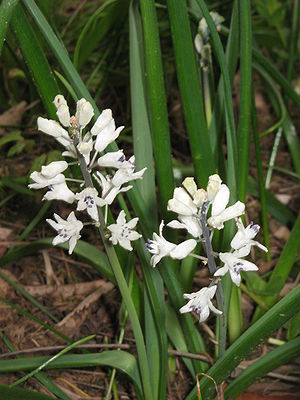Roman hyacinth
| Roman hyacinth | ||||||||||||
|---|---|---|---|---|---|---|---|---|---|---|---|---|

Roman hyacinth ( Bellevalia romana ) |
||||||||||||
| Systematics | ||||||||||||
|
||||||||||||
| Scientific name | ||||||||||||
| Bellevalia romana | ||||||||||||
| Sweet |
The Roman hyacinth ( Bellevalia romana ) is a species of the genus Bellevalia in the asparagus family (Asparagaceae).
features
The Roman hyacinth is a leafless, perennial bulb plant . The stem is leafless and reaches heights of 15 to 40 centimeters. The onion is surrounded by a membranous shell (tunic). The 3 to 6 leaves form a basal rosette. They are longer than the stem and 5 to 15 millimeters wide. When blooming, the inflorescence is elongated. It consists of 20 to 30 funnel-shaped flowers that sit on upright stems. The petals are white when they open and sometimes blue at the base, later they take on a brownish color. They are 8 to 10 millimeters long and fused together, their free tips are longer than the tube. The anthers are purple.
Flowering time is from March to May.
The number of chromosomes is 2n = 8.
Occurrence
The Roman hyacinth occurs in the central Mediterranean area , more rarely in the eastern Mediterranean area and in southwest France. It grows in wet meadows, fields and vineyards.
literature
- Ehrentraud Bayer, Karl-Peter Buttler , Xaver Finkenzeller, Jürke Grau: Plants of the Mediterranean (The Colored Nature Guide). Mosaik Verlag GmbH, Munich 1986.
